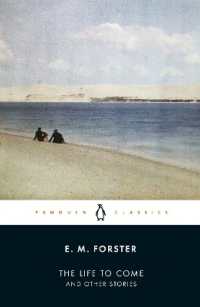- ホーム
- > 洋書
- > 英文書
- > Architecture
Full Description
We inhabit a vulnerable planet. The devastation caused by natural disasters such as the southern Asian tsunami, Hurricanes Katrina and Ike, and the earthquakes in China's Sichuan province, Haiti, and Chile-as well as the ongoing depletion and degradation of the world's natural resources caused by a burgeoning human population-have made it clear that "business as usual" is no longer sustainable. We need to find ways to improve how we live on this planet while minimizing our impact on it. Design for a Vulnerable Planet sounds a call for designers and planners to go beyond traditional concepts of sustainability toward innovative new design that fosters regeneration and resilience.
Drawing on his own and others' experiences across three continents, Frederick Steiner advocates design practice grounded in ecology and democracy and informed by critical regionalism and reflection. He begins by establishing the foundation for a more ecological approach to planning and design, adopting a broad view of ecology as encompassing human and natural, urban and wild environments. Steiner explores precedents for human ecological design provided by architect Paul Cret, landscape architect Ian McHarg, and developer George Mitchell while discussing their planning for the University of Texas campus, the Lake Austin watershed, and The Woodlands. Steiner then focuses on emerging Texas urbanism and extends his discussion to broader considerations beyond the Lone Star State, including regionalism, urbanism, and landscape in China and Italy. He also examines the lessons to be learned from human and natural disasters such as 9/11, Hurricane Katrina, and the BP oil spill. Finally, Steiner offers a blueprint for designing with nature to help heal the planet's vulnerabilities.
Contents
Preface
Acknowledgments
Introduction: Interdisciplinary Design and the Fate of Our Planet
I. Living Urban Environments
1. Architecture and the Wealth of Regions
2. Sustaining Design: The Solar Decathlon Competitions
3. Twenty-First-Century Architecture
4. Architecture Has Left the Building: The Sustainable Sites Initiative
5. Making Territory: The Potential of Landscape Urbanism
II. Lessons from Paul Cret, Ian McHarg, and George Mitchell
6. City Limits: Pioneer Plans in Austin
7. The Woodlands: The Ecological Design of a New City
III. Emerging Urbanism in Texas
8. The Trinity River Corridor: Another Emerald Necklace or an Emerald Choker?
9. Making Limoncello from Lemons: The Blanton Museum of Art Plaza Design
10. True Urbanism: The Design of Performance Park in the Dallas Arts District
11. Legacies
IV. New Regionalism in Texas and Beyond
12. The Green Heart of Texas
13. Envision Central Texas
14. The Texas Triangle Megaregion
15. New Regionalism
V. Learning from Abroad
16. Environmental Readings: The Italian Design Tradition
17. Autumn Moon: Design and Planning in China
VI. Learning from Disaster
18. In Search of a Fitting Tribute: The United Flight 93 Memorial
19. Resilient Foundations: Planning for the Gulf Coast After Hurricane Katrina
VII. Conclusion
20. The Sedimentation of Our Minds: Prospects for New Design Thinking
Notes
Bibliography
Index







